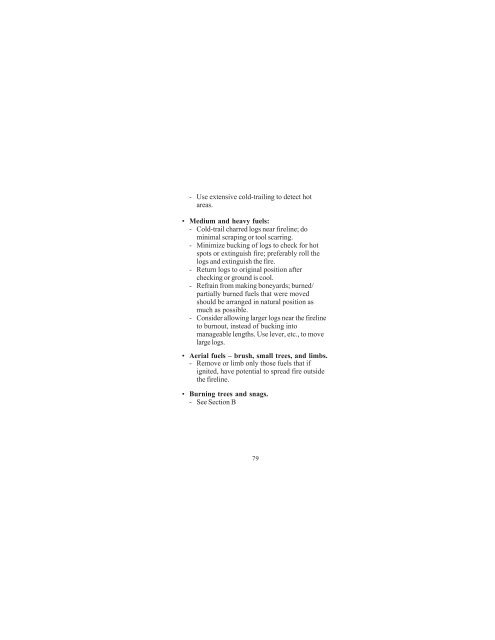Incident Response Pocket Guide - KUMEYAAY.info
Incident Response Pocket Guide - KUMEYAAY.info Incident Response Pocket Guide - KUMEYAAY.info
- Use extensive cold-trailing to detect hot areas. • Medium and heavy fuels: - Cold-trail charred logs near fireline; do minimal scraping or tool scarring. - Minimize bucking of logs to check for hot spots or extinguish fire; preferably roll the logs and extinguish the fire. - Return logs to original position after checking or ground is cool. - Refrain from making boneyards; burned/ partially burned fuels that were moved should be arranged in natural position as much as possible. - Consider allowing larger logs near the fireline to burnout, instead of bucking into manageable lengths. Use lever, etc., to move large logs. • Aerial fuels – brush, small trees, and limbs. - Remove or limb only those fuels that if ignited, have potential to spread fire outside the fireline. • Burning trees and snags. - See Section B 79
Sustained Line Production Rates of 20-Person Crews for Construction, Burnout, and Holding in Chains/Hour Fire Behavior Specific Crew Type Fuel Model Conditions Type I Type II 1 Short Grass Grass Tundra 30 9 18 5 2 Open Timber/ All 24 16 Grass Understory 3 Tall Grass All 5 3 4 Chaparral Chaparral High Pocosin 5 4 3 2 5 Brush All 6 4 6 Dormant Brush/ Hardwood Slash Black Spruce Others 7 6 5 4 7 Southern Rough All 4 2 8 Closed Timber Litter Conifers 7 40 5 24 9 Hardwood Litter Conifers Hardwoods 28 40 16 24 10 Timber All 6 4 (Litter & Understory) 11 Logging Slash, Light All 15 9 12 Logging, Slash All 7 4 Medium 13 Logging Slash, Heavy All 5 3 NOTE: Allowances have been made in production rates for rest periods and cumulative fatigue. 80
- Page 39 and 40: Structural Triage and Search Assess
- Page 41 and 42: Evaluating Search Urgency FACTOR RA
- Page 43 and 44: NOTES _____________________________
- Page 45 and 46: First Aid Guidelines LEGALITY Do on
- Page 47 and 48: 36 CPR Determine responsiveness - G
- Page 49 and 50: Disaster Size-up Information TRIAGE
- Page 51 and 52: NOTES _____________________________
- Page 53 and 54: Aviation Watch Out Situations • I
- Page 55 and 56: Helicopter Passenger Briefing All p
- Page 57 and 58: Personal Protective Equipment for F
- Page 59 and 60: Helicopter Landing Area Selection C
- Page 61 and 62: One-Way Helispot 50
- Page 63 and 64: Helicopter Hand Signals Clear to St
- Page 65: Paracargo and Aerial Retardant Oper
- Page 68 and 69: Directing Retardant and Bucket Drop
- Page 70 and 71: Aircraft Mishap Response Actions Ti
- Page 72 and 73: USFS Visual Signal Code Ground To A
- Page 74 and 75: Energy Release Component (ERC) The
- Page 76 and 77: Haines Index (HI) The Lower Atmosph
- Page 78 and 79: Thunderstorm Safety Approaching thu
- Page 80 and 81: Windspeed Ranges Frontal winds ....
- Page 82 and 83: Relative Humidity - 5000-9200’ El
- Page 84 and 85: Procedural Chain Saw Operations Pro
- Page 86 and 87: Logistical Considerations: • Brin
- Page 88 and 89: - Burning-out and use of gunnysack
- Page 92 and 93: Dozer Fireline Construction Rates f
- Page 94 and 95: Dozer Use Hand Signals STOP - Back
- Page 96 and 97: Foam Concentrate to Add % M A O F O
- Page 98 and 99: Average Perimeter in Chains One cha
- Page 100 and 101: Fire Cause Determination Checklist
- Page 102 and 103: Phonetic Alphabet Law Enforcement I
- Page 104 and 105: Local Frequencies 93
- Page 106 and 107: NOTES _____________________________
- Page 108 and 109: BRIEFING CHECKLIST Situation Fire n
- Use extensive cold-trailing to detect hot<br />
areas.<br />
• Medium and heavy fuels:<br />
- Cold-trail charred logs near fireline; do<br />
minimal scraping or tool scarring.<br />
- Minimize bucking of logs to check for hot<br />
spots or extinguish fire; preferably roll the<br />
logs and extinguish the fire.<br />
- Return logs to original position after<br />
checking or ground is cool.<br />
- Refrain from making boneyards; burned/<br />
partially burned fuels that were moved<br />
should be arranged in natural position as<br />
much as possible.<br />
- Consider allowing larger logs near the fireline<br />
to burnout, instead of bucking into<br />
manageable lengths. Use lever, etc., to move<br />
large logs.<br />
• Aerial fuels – brush, small trees, and limbs.<br />
- Remove or limb only those fuels that if<br />
ignited, have potential to spread fire outside<br />
the fireline.<br />
• Burning trees and snags.<br />
- See Section B<br />
79



